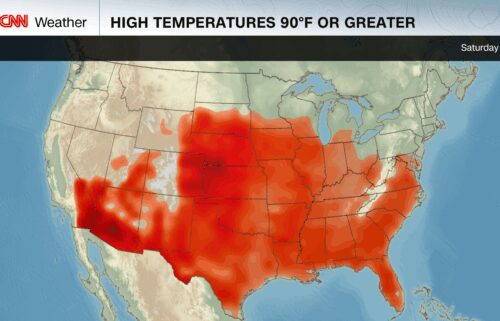A winter storm is about to paint 1,400 miles of the South with snow and ice, threatening major impacts
By Mary Gilbert, CNN Meteorologist
(CNN) — A disruptive winter storm will soon paint the South with snow, ice and rain as the eastern two-thirds of the United States grapples with the coldest air of the season.
Unusually cold temperatures have dipped deep into the South and will allow the storm to put out a few inches of snow and dangerous ice over a nearly 1,400 mile section of the South from North Texas to the North Carolina coast, threatening major to extreme impacts in a region less adapted to winter weather.
Around 80,000 homes and businesses from Missouri to Virginia were still without power Wednesday morning after the last winter storm, according to PowerOutage.us. Some have been without power since Sunday, enduring the dangerous cold temperatures that are cold even for the coldest month of the year.
Spotty wintry weather from the new storm will begin Wednesday night in western Texas with light snow and freezing drizzle as the storm organizes. Thursday will be the most impactful day for winter weather for much of the southern Plains as the storm hits its stride.
Snow and sleet could begin around sunrise Thursday in northern Texas, including in the Dallas-Fort Worth metroplex, and continue through Thursday night. Some freezing rain could mix in during the afternoon as temperatures briefly climb just above freezing.
A similar mix will begin Thursday morning in Oklahoma and Arkansas. More mixing will keep snow totals a bit lower than initially forecast but will also create hazardous conditions by introducing ice to a larger population.
Any amount of ice is dangerous; just a thin layer — even a tenth of an inch — can turn paved surfaces into skating rinks, causing people to slip and vehicles to slide out of control, like what occurred over the weekend in the central US.
At least moderate impacts from the storm are expected in parts of Texas and Oklahoma given the threat for snow and ice, according to the Winter Storm Severity Index. A few areas could encounter major or even extreme impacts from this storm, meaning considerable disruptions to daily life and dangerous travel conditions are likely.
Frigid temperatures will increase power demands in Texas but grid conditions are expected to be normal, ERCOT — the operator responsible for the state’s electrical grid — said in a weather watch issued Sunday. The state’s grid failed during 2021’s disastrous winter storm and prolonged deep freeze, resulting in the deaths of more than 200 people.
Rain and perhaps a few embedded thunderstorms will soak central and south Texas, including Austin and Houston, Thursday. Flooding is possible, especially in coastal Texas where heavy thunderstorms that bubble to life just off the coast could slowly push ashore.
The storm will track farther east Thursday night and Friday and bring messy winter weather to much of the South. Small shifts in its track are still possible and could change snow and ice outcomes.
Snow totals will be highest from far northeast Texas and southeast Oklahoma through Tennessee and the southern Appalachians. Several inches of snow could fall across this area and eclipse half a foot in spots from central Arkansas to the southern Appalachians.
Northern portions of Mississippi, Alabama and Georgia could record 3 inches or more of snow from Thursday night through Friday night. Some of these areas could start as snow but change over to an icy mix as warmer air enters the area.
This will likely be the case in Atlanta, which hasn’t had at least an inch of snow in nearly seven years, but has a moderate chance of it with this storm. Precipitation begins as snow early Friday morning but will mix with freezing rain in the afternoon through the evening as temperatures warm to near freezing.
Precipitation quickly expands east Friday night as the storm approaches the Atlantic Coast and a mix of snow and ice will reach the Carolinas. Charlotte, North Carolina, hasn’t recorded measurable snow – at least 0.1 inch – in nearly two years but likely breaks that snow drought by this weekend.
Early forecasts hinted at the possibility that the storm could deliver significant snow to the mid-Atlantic and Northeast by the weekend, but that scenario is appearing less likely. Still, a separate storm diving south out of Canada could work in tandem with the southern storm to pull moisture north and spread precipitation to much of the East.
A quick round of snow totaling 1 to 3 inches or less is possible for much of the mid-Atlantic and Northeast Friday night into early Saturday morning. The storm quickly clears out of the East Saturday morning, leaving gusty winds in its wake, especially near the coast.
CNN Meteorologist Elisa Raffa contributed to this report.
The-CNN-Wire
™ & © 2025 Cable News Network, Inc., a Warner Bros. Discovery Company. All rights reserved.

